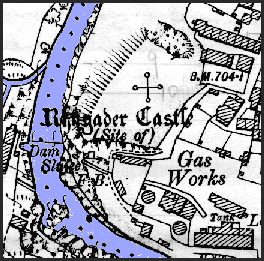
Rhayader and the Elan Valley
Rhayader Castle
by Stephen Collard
Detail from an O.S. 6"map showing
the site around 1904
(far right)
Powys
County Archives
 Today very little remains of Rhayader
Castle, only a deep trench on the north side cut into the rock
near the entrance to Waun Capel Parc. This channel is popularly
known as the Moat. The Castle at Rhayader originally occupied
a large area of ground, in fact most of the north west side of
the town.
Today very little remains of Rhayader
Castle, only a deep trench on the north side cut into the rock
near the entrance to Waun Capel Parc. This channel is popularly
known as the Moat. The Castle at Rhayader originally occupied
a large area of ground, in fact most of the north west side of
the town.The area today known as ‘The Castle’, is believed to have originally been the Keep and the north west lookout point, about 150 yards to the south of this was the castle's mill. This mill, also long gone, now has on its site a supermarket. Historians claim the castle was of wooden construction, due to the plentiful supply of local timber.
The castle mound
above the river
c.1900
Photograph by kind permission of
Stephen Collard
 An
interesting account by Giraldus Cambrensis (Gerald the Welshman)
written in 1188 relates how a delinquent locked up in Rhayader
Castle arranged for his wife to smuggle a magic bell into the
dungeon. This bell named ‘Bangu’ and believed to have
belonged to St. David, was given to the man’s gaolers to
buy his release. On receiving this ransom they decided to keep
the bell and not release their prisoner. Giraldus goes on to
tell us how that very night ‘as if by Divine vengeance’
the whole town was consumed by fire excepting the wall on which
the bell was hung.
An
interesting account by Giraldus Cambrensis (Gerald the Welshman)
written in 1188 relates how a delinquent locked up in Rhayader
Castle arranged for his wife to smuggle a magic bell into the
dungeon. This bell named ‘Bangu’ and believed to have
belonged to St. David, was given to the man’s gaolers to
buy his release. On receiving this ransom they decided to keep
the bell and not release their prisoner. Giraldus goes on to
tell us how that very night ‘as if by Divine vengeance’
the whole town was consumed by fire excepting the wall on which
the bell was hung. The cleared
Rhayader Castle
mound in late
summer 1998
 The
castle over the last eight centuries has had most, if not all,
of its features eroded away.
The
castle over the last eight centuries has had most, if not all,
of its features eroded away.
In 1998 the Castle site was cleared of brambles and weeds,
and information boards have been erected by Rhayader 2000 showing
various points of interest.
Rhayader & District History Archives
www.orchard.headweb.co.uk/archives